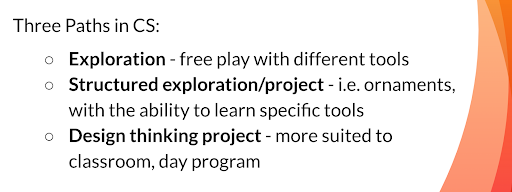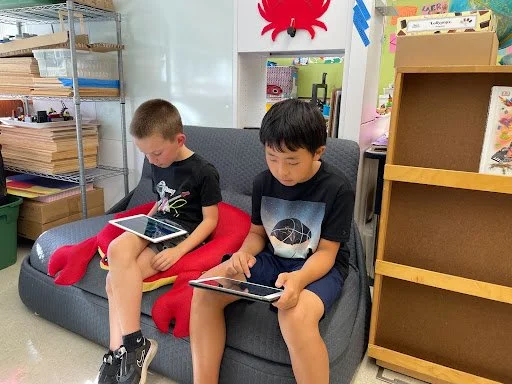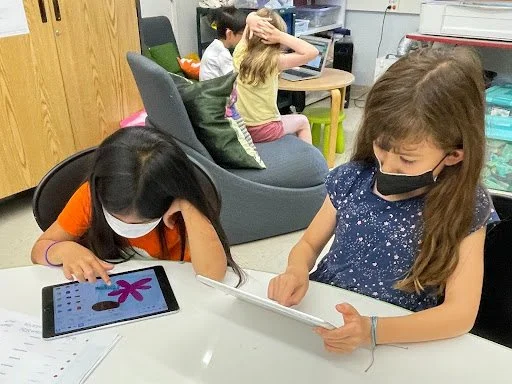By Rebecca Eldredge
My journey at Hanahauʻoli School started over 30 years ago. I was hired as the school’s Science and Computer Teacher. Five years into my time at Hanahauʻoli, I took a year’s sabbatical and completed my Master’s of Education with a focus in Educational Technology. I returned to teach in the multiage second and third grade class for two years. Then I became the Technology Coordinator. Several years later I moved to being the school’s Technology Integration Specialist where I worked more with teachers, guiding them with integrating technology projects into their curriculum. Eventually I decided to step back into the classroom and taught in the fourth and fifth grade multiage class until our Head of School asked me to facilitate a new endeavor for our 106 year-old progressive school – The Collaborative Studio. In this blog I share a brief history and introduction to this new makerspace and the ways it helps Hanahau‘oli students explore, experiment, create, collaborate, and learn by doing.
Getting the Collaborative Studio Off the Ground
Since its founding in 1918, Hanahauʻoli School has had a “shop,” which is now called the Physical World Lab. “In Physical World Lab, children are invited to explore science and social studies concepts as they learn to use woodworking tools, investigate simple machines, discover the physics of sound or create a replica of an imaginary island. The program builds on the Deweyan notion that thinking and doing are connected and satisfaction results from a job well-done using one’s hands” (Hanahau’oli School website, 2024). In 2019, one hundred years later, the school wanted to explore a new type of “makerspace.” This is when we experimented with creating a Collaborative Studio where students could come to work and play in new ways. “Looking back at our history, it's easy to see how progressive schools’ modern embrace of technology, design, and invention” and in our case the newly established Collaborative Studio “is a natural outgrowth of shop class, which the forefathers and mothers of Progressive Education invented. It’s the crux of that whole idea of getting kids out from behind their stultifying rows of desks and working on projects, in teams'' (Little & Ellison, 2015, p. 125).
This progressive education value of “hands on learning” and “making” is emphasized in the modern book, Free to Make, by Dale Daugherty and Ariane Conrad (2016). They explain:
We have to be constantly learning new skills and coming up with new ideas, changing as the world changes. How can more and more people have engaging, purposeful, gratifying work, the kind of work that makers do? The maker mindset seems more essential than ever: a sense of agency, self-determination, self-reliance, resourcefulness, collaboration, flexibility, and a can-do attitude (p. 231).
We wanted to model our new space in line with the philosophy above. In addition, we wanted it to be a place where students could collaborate with others. Thus, the Collaborative Studio was born.
In the beginning, the Collaborative Studio was opened for anyone enrolled in our After-School Camp (ASC) program. The decision was made to launch the new initiative as a part of ASC because there was more flexibility with scheduling and time as we worked to get the project off the ground. Prior to the introduction of the Collaborative Studio during ASC, our after school program was basically a time for snack, multiage play, and enrichment classes. To add to the students’ options for play, we wanted to experiment with a studio space where children could drop in at their convenience to work as they wish. We tested out offering high-tech, low-tech and no-tech options. This included a variety of choices: photography, coding, robotics, claymation, stop motion, video, 3D design, laser printing, and sewing, by hand or on a machine. We also incorporated a design center we call Idea Box in other classrooms at the school. In this space, children can build structures, games, organizers and other things using recycled materials.
The initial days of the Collaborative Studio were a huge success, but unfortunately, the COVID-19 pandemic struck in Spring 2020 and we had to close the space. Eventually, when students returned to school, the Collaborative Studio became a classroom to accommodate the smaller pandemic era class sizes that were needed for our health and safety. I was pulled back into the classroom to teach in Kulāiwi (our 2nd and 3rd grade multi-age classroom), and the dreams of the Collaborative Studio were put on hold.
Then, in August 2022, we excitedly relaunched the Collaborative Studio. We provided the same offerings as in its initial launch. In addition to the ASC open studio time, we opened the Collaborative Studio to student groups during the school day! We also decided to add 3D pen work and paper circuitry. We followed the childrens’ interests in coding, and created lots of options for them to be the producers of technology, going beyond simply being consumers of it. The number of children gaining experience with coding and design multiplied as they experimented with computer games, coding music for dance parties, and designing other simple entertainment solutions. The Collaborative Studio is now back and we are delighted with the way learning-by-doing has expanded at Hanahauʻoli.
How Does the Collaborative Studio Work?
While resembling a makerspace, the Collaborative Studio not only focuses on making but also doing so with others. Learning is a social process and the Collaborative Studio leverages the power of building upon others’ ideas, experimenting and reflecting together, and feeling pride in creating something that didn’t exist before. The Collaborative Studio offers exploration using the design thinking process. After reviewing many design thinking processes, we settled on KQED PBS Learning Mediaʻs Engineering for Good design process. In a collaboration between the Director of Faculty and Curriculum Upper Elementary, the Sixth Grade Teacher, the Physical World Lab Teacher, and myself this graphic was modified to help simplify the language of design thinking for the children and use consistent language across our campus. Students can refer to this poster when working in the Collaborative Studio.
Children are also free to work in this space as they wish. As the Collaborative Studio Teacher, I study children’s natural curiosity and interest. I use what I learn about individual learners and the group to create a stimulating environment and options for exploration. I recognize “the maker in every child and [that] guiding the development of young makers is what we must do as adults to care for our children and our communities' children” (Daugherty & Conrad, 2016, p.271). I make sure the children have access to a variety of options and tools. I’ve learned that children enjoy creating on their own and they also like having structured exploration for project work. I foster an environment where all are welcome to create on their own or collaborate with friends as they work.
At the Collaborative Studio, “we are not searching for an ‘ideal’ space, but one that is capable of generating its own change, because an ideal space, an ideal pedagogy, an ideal child or human being does not exist, but only a child, a human being, in relation with their own experiences, times and culture” (Ceppi & Zini, 1998, p. 115). While offering both students and teachers another option for play, we provide guided, structured projects and explorations as well as opportunities to engage in self-directed projects that support progress towards all of our school’s General Learner Outcomes. This is captured in the overall Collaborative Studio vision and paths.
Early Discoveries About the Impact of the Collaborative Studio
The reflections of children share much about the Collaborative Studio’s strengths and positive contributions to our learning environment. To follow are some of their comments, in their own words.
“The Collaborative Studio is always fun. It gives you opportunities to try new things. I like sewing and being creative, trying to put my ideas into my project. I like helping the little ones try new things for the first time because they’re always so positive and excited to try them.” – 6th Grade Student
“I like everything about the Collaborative Studio. I really like sewing in the Collaborative Studio. I like sewing because I can sew on a sewing machine and it’s fun for me.” – Kulāiwi (2nd/3rd Grade) Student
“I like signing up to come to the Collaborative Studio during camp. I learned how to use the 3-D pen. I like making designs. I made a dog and a gate and I used idea box to make a frame to show others.” – Po‘e Ka‘ahele (4th/5th Grade) Student
“I like coming to the Collaborative Studio every day, because I like coding games. It's fun to do and then I can play my own games.” – Kulāiwi (2nd/3rd Grade) Student
As the quotes above illustrate, the children come with wonderfully creative ideas about what they’d like to make or do. Much of the interaction taking place occurs across class and age groups, and this added opportunity for multiage learning fosters special collaborations that support learning from and teaching one another. Additionally, I've learned that having some structures or constraints can also help to launch interest! Children like having examples in the room and they spark added engagement and ideas. I’ve also observed that when we focus on a specific topic or theme, more children choose to visit the Collaborative Studio. When we offered stop motion as our main activity for a week in the Collaborative Studio, anyone could still visit to work on their projects, but there were added stop motion projects and opportunities to learn more about this area of focus, and we saw many new faces choose to sign up for a visit.
Final Reflections and Considerations for Other Educators
Makerspaces can provide access to training and create a supportive environment where more people can learn to do something that they might have thought was too hard for them to do. They can also help makers get better, improving their ability to create and make something, often by joining forces with others, who share a common interest. (Daugherty & Conrad, 2016, Page 266)
The Collaborative Studio provides a unique opportunity for children to learn, follow and develop passions. They come with a variety of ideas they want to bring to fruition. They trust they will be encouraged by their peers who celebrate, admire, and learn from their work. And they know they have the support of their teacher, who will find ways to bring missing materials in. Children love signing up to work in the Collaborative Studio during our After School Camp program time. It’s a full house every day! I see children working with friends from their and other classes. Children enjoy building and creating together, supporting and helping each other on various projects. I am encouraged when I see older children teaching younger children and the youngers teaching their older friends as well. In my classroom there is a “Go To” poster on the wall, listing skills such as sewing, hot glue gun, laser design, ironing, and stop motion. The children listed under these headings serve as extra “teachers” students can ask for help because as Edward Clapp, et al, acknowledges, “Having students play the role of teacher expands what Maker Educators can do in the classroom.” (p. 52).
I recently asked children why we need a Collaborative Studio at Hanahauʻoli and these responses let me know this is a vital part of our program:
“Everybody learns to work together and make things together. We collaborate when we work. I love the Collaborative Studio!” – Kukunaokalā (K/1st Grade) Student
“It teaches you how to work with others and it is so fun too. It also teaches you skills that you might use when you grow up.” – Kulāiwi (2nd/3rd Grade) Student
“We get to be creative and do what we want. We also have a wide range of choices, which is a big part of Hanahau`oli’s beliefs.” – Kulāiwi (2nd/3rd Grade) Student
As we near the four year mark of the Collaborative Studio at Hanahau‘oli, I’ve developed some key considerations for other educators and schools that are looking to implement a program like ours. First, keep the time and schedule organic. I realize this may be challenging as far as scheduling goes, but it is important. Second, be sure to carve out time to plan with teachers and develop integrated projects for their classes. For example, in the Junior Kindergarten Growing Unit, the children looked inward and reflected on their own growth over time and they were learning more about their own time as a baby. I worked with them to make sock babies that they could swaddle and play with. Third, keep equity in the forefront when planning. Fair does not always mean equal; some projects take longer than others. Older children may need more time to dive more deeply into their work so big blocks of time can be created, whereas smaller amounts of time with more frequent visits to the Collaborative Studio might be necessary for younger children. Finally, reflection is the key to growth! We are devoted to reflection at Hanahauʻoli, and involving the children (and their teachers) in this reflection is vital. This can help with future planning and can provide essential feedback to keep children engaged in their learning.
The Collaborative Studio has grown our overall progressive education school program in wonderful ways. It has extended our ability to truly place children at the center of teaching and learning. As Daugherty & Conrad assert in their 2016 book Free to Make, “The future will be made by our children, so they deserve to be a primary focus of a maker space.” (p. 270). The Collaborative Studio is one way to bring this progressive education theory to practice.
Works Cited:
Aust, Andrea. “Engineering for Good.” KQED, 13 Apr. 2017, https://www.kqed.org/quest/267100/engineering-for-good.
Ceppi, G. & Zini, M. (1998). Children, Spaces, Relations - Metaproject for an Environment for Young Children
Clapp, E.P., Ross, J., Ryan, J., & Tishman, S. (2017). Maker-Centered Learning Empowering Young People to Shape Their Worlds
Daugherty, D. & Conrad, A. (2016). Free to Make - How the Maker Movement is Changing Our Schools and Jobs, and our Minds
Little, T. & Ellison, K. (2015). Loving learning: How progressive education can save America’s schools. W. W. Norton & Company.
ABOUT THE Contributor:
Rebecca Eldredge joined the Hanahau‘oli School community in 1991 as a Science and Computer specialist. She was born in Hawaii and raised on Guam. She has her Master’s of Education with a focus in Educational Technology and has served as Hanahau`oli’s Technology Coordinator, Tech Integration Specialist and Po`e Ka`ahele and Kulāiwi Classroom Teacher. Currently she is the Collaborative Studio Coordinator & Auxiliary Programs Liaison. Rebecca helps to bridge the day school and after school programs, running the Collaborative Studio. When not at work she enjoys a variety of sports, including cycling, ultimate Frisbee and disc golf. She has run a couple of marathons and participated in numerous triathlons in both Hawai‘i and Alaska. Some of her hobbies include sewing, quilting, baking, photography, hiking and travel.
















